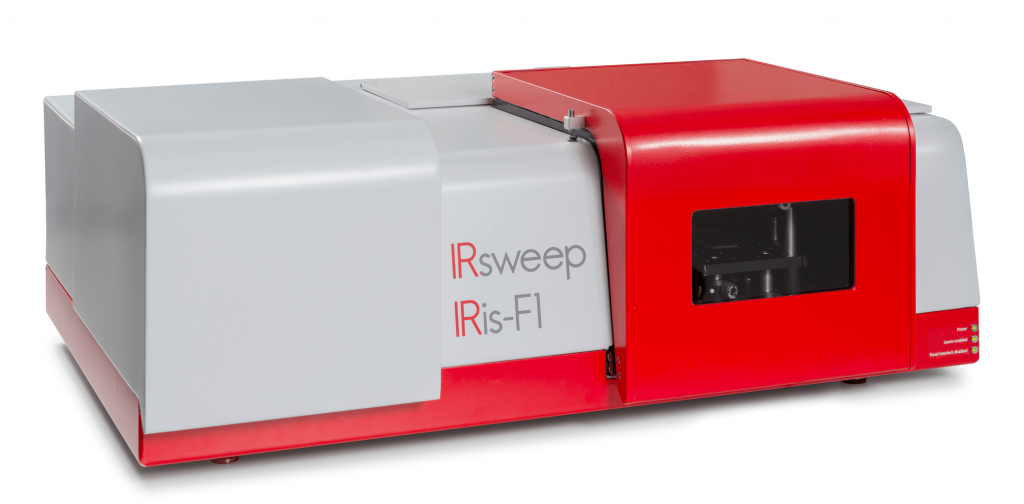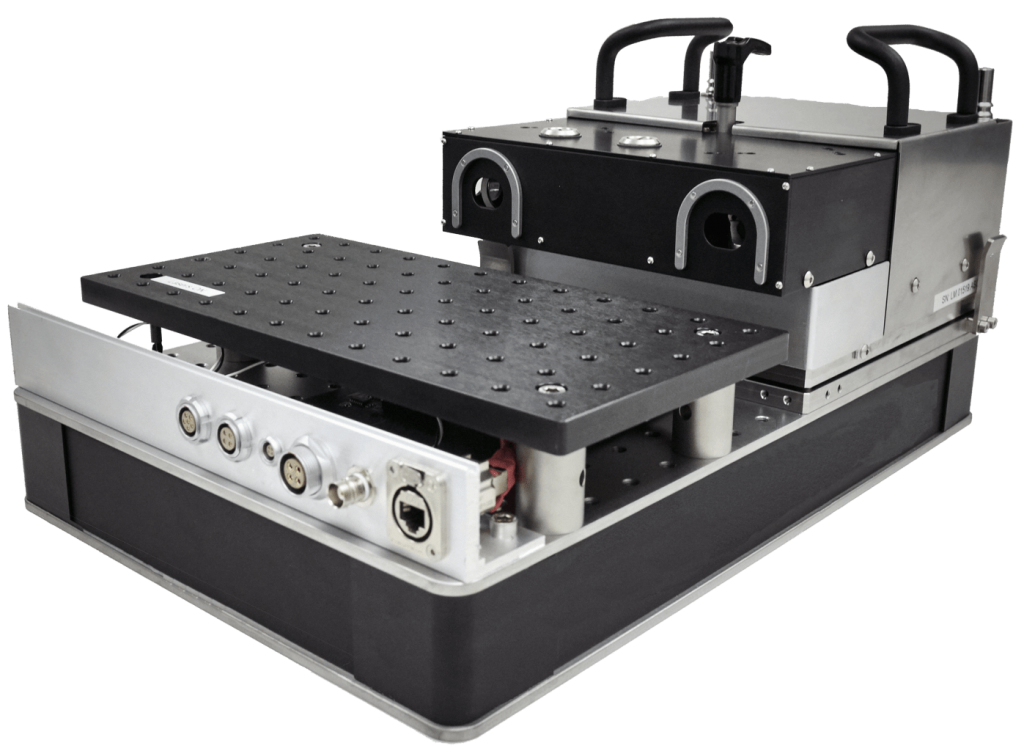Stabilized frequency combs and dual-comb spectroscopy (DCS) have revolutionized the field of high-resolution molecular spectroscopy due to the combination of broadband spectral coverage with exceptional spectral resolution. However, covering the mid-infrared spectral range – hosting the fundamental ro-vibrational transitions of many molecules – has remained a big challenge. QCL-based frequency combs have become available as a powerful mid-infrared frequency comb source. With the IRis-F1 and the step-sweep option, IRsweep offers a fully integrated laboratory spectrometer delivering gapless infrared spectra covering >50 cm-1 in the range from 2200 cm-1 to 900 cm-1 with a spectral resolution < 4×10-4 cm-1.
High-resolution dual-comb spectroscopy with QCLs
The IRis-F1 dual-comb spectrometer samples the absorption spectrum at the precisely defined wavenumbers of the frequency comb laser lines, typically spaced by ~0.3 cm-1. To fully exploit the inherently high spectral resolution of <10-4 cm-1 on each of these sampled points, the point spacing of measurements must be reduced to match this spectral resolution. This is generally achieved by means of spectral interleaving, i.e. by concatenating repeated measurements with shifted laser center frequency.
To obtain an accurate wavenumber axis from interleaved spectra requires a method to precisely determine the wavenumber shifts between consecutive measurement steps. This is achieved in the IRis-F1 spectrometer using the step-sweep technique. Here, the wavelength of the two frequency combs is tuned stepwise and alternating across the gap between adjacent comb lines. As only one frequency comb is tuned at a time, the exact wavenumber during each step can be read directly from the dual-comb measurement2 without additional instrumental complexity. An exemplary spectrum of methane at low pressure is shown in Figure 1.
A wavenumber accuracy of 4×10-4 cm-1 is achieved in a measurement time of less than 10 minutes. This was demonstrated in a recent publication with Prof. Muriel Lepère by comparing the line-positions found in a step-sweep measurement of N2O with reference values from the literature measured by sophisticated, unique laboratory setups (compare Figure 3). In conjunction with the high signal to noise ratio of the IRis-F1 (compare Figure 2), the step-sweep technique is well suited for spectral line parameter studies and atmospheric research. Learn more about the technique in our webinar with Prof. Muriel Lepère.

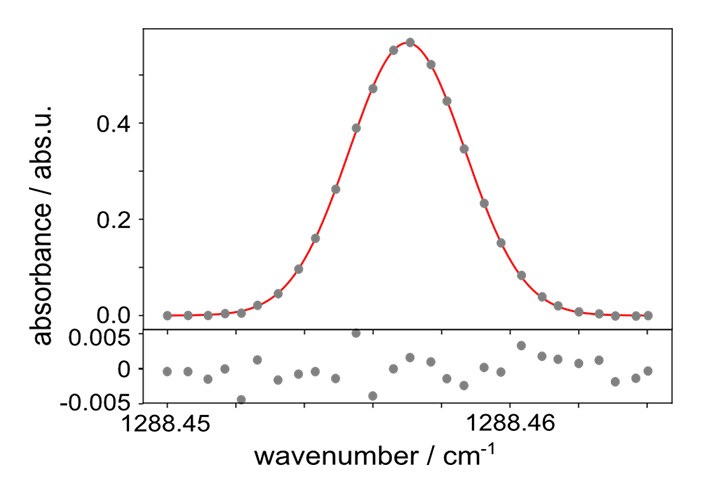 Figure 2. Zoom on Figure 1, with Gaussian fit. Lower panel: residuals of Gaussian fit. Reproduced from 2.
Figure 2. Zoom on Figure 1, with Gaussian fit. Lower panel: residuals of Gaussian fit. Reproduced from 2.
 Figure 3. Deviation between found line positions and reference values, measured for N2O at 0.045 mbar and room temperature. 1 MHz = 3.3×10-5 cm-1. Reproduced from 2.
Figure 3. Deviation between found line positions and reference values, measured for N2O at 0.045 mbar and room temperature. 1 MHz = 3.3×10-5 cm-1. Reproduced from 2.
Time-resolved measurements at high spectral resolution
The step-sweep technique is also applicable to study transient gas species at high spectral and time resolution. To this end, 1 µs – time resolved spectra are measured for each wavenumber step along the wavenumber axis in synchronization with the experiment. This was demonstrated in measurements through a pulsed molecular jet in the group of Prof. Frédéric Merkt and Prof. Martin Quack at ETH Zurich. Molecular jets prepare gases in a rotationally cold state (typically <20 K) for a duration of typically 100s of µs to few ms. High resolution spectra recorded within this short duration can be used to assign quantum-states to the observed ro-vibrational absorption lines in the spectra that would be too congested at higher temperatures. This information is used, for example, to simulate infrared spectra at astronomically relevant conditions, allowing identification of molecular species in space.
Figure 4 shows a small section of the high-resolution spectrum of cold CF4 measured using the time-resolved step-sweep technique. Absorption lines as narrow as 5×10-4 cm-1 are well resolved by the IRis-F1.
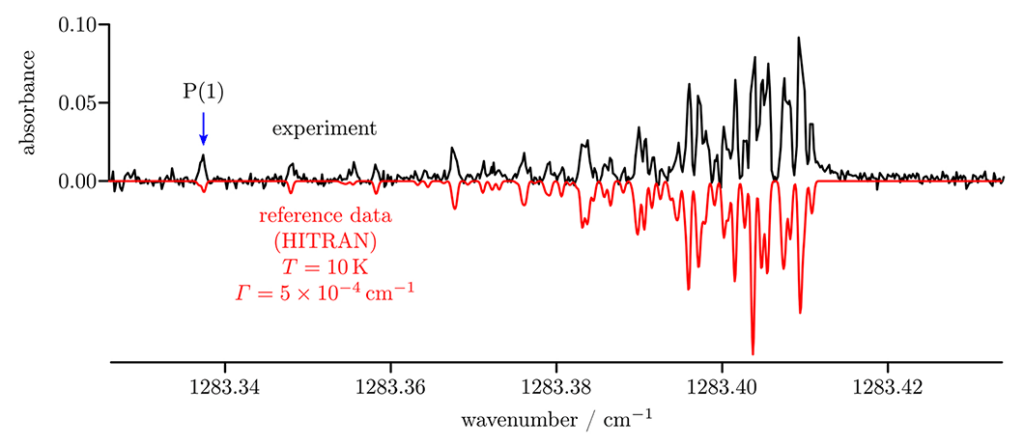
The broadband nature of measurements allows simultaneous observation of a large number of ro-vibrational lines with µs time-resolution. Figure 5 shows the rotational temperature of the gas retrieved from the relative intensities of lines with different ground-state rotational quantum number J’’ using a Boltzmann distribution model.
Further applications of the time-resolved step-sweep technique include, amongst others, transient reactions of gas phase radicals produced by short UV laser pulses or short lived species produced by means of laser ablation.

Rapid high resolution measurements
Another approach to high-resolution spectroscopy with the IRis-F1 was developed and employed in Empa’s environmental technology lab. In the rapid-sweep mode, the laser currents are swept rapidly to tune the wavelength across the gap between adjacent comb lines, yielding gapless spectra in a measurement time of 120 ms, with as little as 6 ms possible. As both lasers are tuned simultaneously, the momentary wavelength cannot be read directly from the dual-comb measurement. To achieve an accurate calibration of the wavenumber axis, the group followed different approaches using reference spectra, unbalanced Mach-Zehnder interferometers and line-locked reference lasers. Even without additional hardware needed to obtain an accurate wavenumber axis, the IRis-F1 in rapid-sweep mode yields reproducible high-resolution spectra well suited for e.g. quantification of gas mixtures. Figure 6 shows an example spectrum of a mixture of different hydrocarbons, featuring both, broadband and narrow line absorption features. Learn more about the rapid-sweep technique in our two webinars with Prof. Lukas Emmenegger, Michele Gianella and Kenichi Komagata.
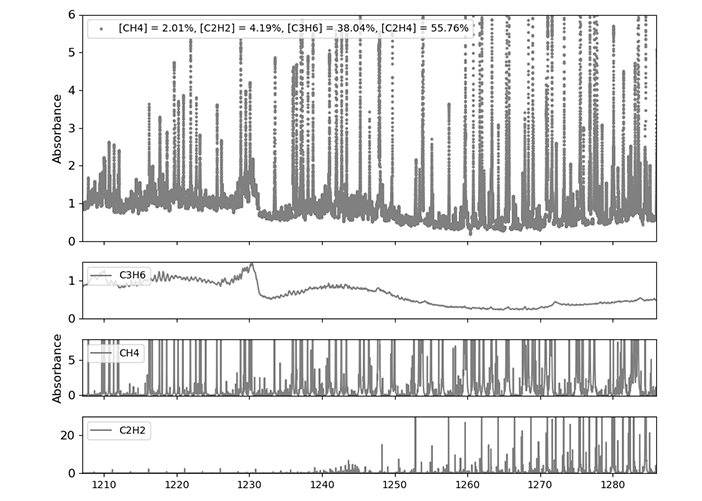
| STEP-SWEEP | TIME-RESOLVED STEP-SWEEP | RAPID-SWEEP | |
|---|---|---|---|
| SPECTRAL RESOLUTION | 1 MHz / 3×10-5 cm-1 |
1 MHz / 3×10-5 cm-1 |
1 MHz / 3×10-5 cm-1 1 |
| SPECTRAL ACCURACY | < 4×10-4 cm-1 |
< 4×10-4 cm-1 |
10-3 cm-1 2 |
| TIME RESOLUTION | Steady-state |
1 µs |
6 ms |
| MEASUREMENT TIME | 6 minutes 3 |
30 minutes 3 |
1 s 3 |
| IDEAL FOR | High resolution and accuracy mid-IR gas phase spectroscopy, reference spectra acquisition, … |
Molecular jets Gas phase reaction kinetics Transient molecular gas species |
Rapid analysis of gas mixtures ms to s dynamic samples |

